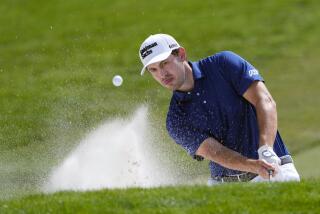Grand Ol’ Man : His Record of Slams Has Been Threatened Before, but Emerson Knows It’s Only a Matter of Time Before Sampras Breaks the Tie That Binds
Our immense, insatiable fascination with statistics and records has created a veritable cottage industry--the pursuer and pursued, the legend-in-waiting and the icon.
Blame it on Mark McGwire and Sammy Sosa. Baseball reinvented itself with the Great Home Run Chase of Roger Maris last summer--with McGwire and Sosa doing the heavy lifting and Maris’ family in a nearby field box, flown in to participate in the ceremonial torch passing.
The relationship between the chased and the chaser often becomes a story in itself. Consider Gordie Howe and Wayne Gretzky. Howe made news when he followed Gretzky from city to city as Gretzky closed in on one of Howe’s records, for points, but stayed away when Gretzky topped Howe’s record for goals.
McGwire and Sosa took it to an exalted level in their double- barreled pursuit of Maris, however. The difference quickly became clear to someone who should know, former Australian tennis great Roy Emerson. Until July, when Pete Sampras won his sixth Wimbledon championship, Emerson had reigned as winner of the most men’s Grand Slam singles titles, 12.
Now that Sampras has the chance to claim sole ownership of the record at the U.S. Open, which starts Monday, the focus has pulled Emerson back into the orbit of celebrity.
Sampras wasn’t the first to threaten Emerson’s record. Bjorn Borg and Rod Laver each won 11 Grand Slam titles--but their pursuit of Emerson never merited this sort of attention.
“None of us ever thought about adding them all up,” Laver said.
Emerson concurred, saying he never worried about records, not when he won his first Grand Slam singles title in 1961, nor his last in 1967.
“No one was really counting a few years ago,” Emerson said. “Even when Borg and Laver got to 11, there wasn’t too much publicity about it, or too much interest.
“Since baseball players have been creating such a great interest with home run records, more interest has been shown in the record and Grand Slams in tennis. Because Pete’s been creeping up there, there’s been a tremendous amount of interest in the last year or two.”
Sampras has been quietly persistent. He joined Emerson in the record book by winning Wimbledon six times, the U.S. Open four, the Australian Open twice. His three most recent Slam titles were at Wimbledon the last three years. He started the quest by beating Andre Agassi in the U.S. Open final in 1990 and tied the record by defeating Agassi at Wimbledon in July.
“I’d love to [break the record] and love to do it where it all started for me in 1990,” Sampras said. “It’s not going to be easy.”
True enough. But there has been an air of inevitability about this chase. Sampras was more stressed out when he was chasing other marks, namely, finishing No. 1 for six consecutive years. And his futile pursuit of the French Open title, specifically this year, had him suffering a confidence crisis.
Once, Emerson shared Sampras’ dislike of clay. But he persevered, got over it, and won the French Open twice, in 1963 and 1967.
“[Sampras] has got the tools to win the French,” Emerson said. “It’s a lot about confidence with him. He’s won Rome [also on clay] and it’s a lot slower there than the French.”
This summer, Sampras was relaxed and playing extraordinary tennis until he was injured earlier this month at Indianapolis. Emerson has kept track, and although he picks countryman Patrick Rafter to win the U.S. Open, he knows it is simply a matter of time until he loses his grasp on the record.
“How do I feel about Pete passing my record?” he said. “Obviously, it’s going to be done. And I think Pete is a great champion and records are to be broken. I’ll obviously be a little sad about it because it’s nice to have the most, but good luck to Pete.”
Emerson, 62, does feel strongly that another of his records will survive. He won a total of 28 Grand Slam titles, the 12 in singles and 16 more in doubles. And the doubles titles came in impressive fashion--with five different partners.
“There’s one record that’s never going to be broken--and that’s singles and doubles, unless they come up with prize money [for doubles], which I would like to see happen,” he said at his home in Newport Beach. “That’s the only way I can see the doubles game getting back to where it should be.”
One of the best aspects about the Sampras-Emerson record is the chance to educate a whole new generation, that, indeed, there was tennis before Pete, Andre, Mac, Bjorn and Jimmy. Besides his mastery in Grand Slam events, Emerson, fondly known as “Emmo,” also had a superb Davis Cup record: eight championship teams in a nine-year span, a 21-2 record in singles and 13-2 in doubles.
In 1962, when Laver won all four majors for his first of two Grand Slams, he beat Emerson in three of the four finals, and found Emerson a formidable opponent for reasons beyond shot-making.
“Mainly it was his fitness,” Laver said. “He had a great return of serve. He competed as well as anybody on the tour. He was really a professional before his time.”
Said Emerson, “I tried to be in good physical shape. I didn’t have the ability to get cheap points on my serve. I had a serve that came back.”
In the pre-Open era--before 1968--there was obviously less media attention and, of course, less money. Emerson jokes about his prize for winning Wimbledon one year--a gift certificate worth 25 pounds at a prominent London sporting-goods store, Lillywhites.
There were some benefits in those days. Players could take some time off to work on their weaknesses. When Emerson was 21, he left the tour for a season, stayed at home in Australia and retooled his forehand and serve under the guidance of Frank Sedgman.
“I just tried to improve my forehand--it was pretty pitiful,” he said, laughing. “I was very wristy and flicky with it. It wasn’t a consistent stroke.”
Twelve Grand Slam singles titles later, something must have gone right in all those training sessions in Melbourne. So, just how would Emerson in his prime have fared against Sampras at his very best?
“That’s difficult to say,” Emerson said. “I think we would have competed well. I wouldn’t have enjoyed facing his serve too much. Out of five sets, I feel like I would have a chance against Pete. Out of a three-set match, I don’t think he would have much time to cool down. He’s a pretty hard customer in the best-of-three-set match.
“I feel the only way you can get to Pete is if his serve goes off a little bit. When he’s booming it in, you aren’t getting too many back and you can’t work him too much. Out of five sets, on a slower surface, you might get to look at a few more balls.”
Emerson and Sampras. Sampras and Emerson.
Together in history . . . at least for another fortnight.
(BEGIN TEXT OF INFOBOX / INFOGRAPHIC)
Dozen Matter
Pete Sampras, who is tied with Roy Emerson with 12 Grand Slam championships, vies for his fifth U.S. Open title starting Monday. A look at each of their 12 Grand Slam victories:
PETE SAMPRAS
AUSTRALIAN OPEN
* 1994: def. Todd Martin
* 1997: def. Carlos Moya
WIMBLEDON
* 1993: def. Jim Courier
* 1994: def. Goran Ivanisevic
* 1995: def. Boris Becker
* 1997: def. Cedric Pioline
* 1998: def. Ivanisevic
* 1999: def. Andre Agassi
U.S. OPEN
* 1990: def. Agassi
* 1993: def. Pioline
* 1995: def. Agassi
* 1996: def. Michael Chang
ROY EMERSON
AUSTRALIAN OPEN
* 1961: def. Rod Laver
* 1963: def. Ken Fletcher
* 1964: def. Fred Stolle
* 1965: def. Stolle
* 1966: def. Arthur Ashe
* 1967: def. Ashe
FRENCH OPEN
* 1963: def. Pierre Darmon
* 1967: def. Tony Roche
WIMBLEDON
* 1964: def. Stolle
* 1965: def. Stolle
U.S. OPEN
* 1961: def. Laver
* 1964: def. Stolle
U.S. OPEN
WHEN
Starts Monday
WOMEN’S FINAL: Sept. 11
MEN’S FINAL: Sept. 12
WHERE
USTA National Tennis Center, Flushing Meadows, N.Y.
TOP SEEDS
Men: Pete Sampras
Women: Martina Hingis
TELEVISION
Weekdays: USA
Weekends, holiday:
Channel 2
More to Read
Go beyond the scoreboard
Get the latest on L.A.'s teams in the daily Sports Report newsletter.
You may occasionally receive promotional content from the Los Angeles Times.











